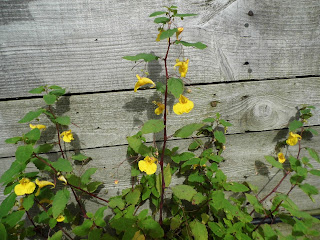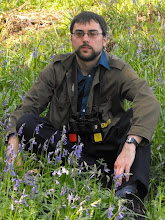Thursday, 22 August 2013
LAKE DISTRICT: Assorted wildlife
Saturday, 17 April 2010
Scotland Trip - Intro & Day 1 (Burghead)
I have visited Scotland on numerous occasions, only to wish I could do some proper birding there. A brief visit may leave you thinking that there are only three species, Buzzard, Chaffinch and Oystercatcher, but there must be loads more, right? Six of us (myself, Gary, Adam and our partners) set off for a week of intensive birding, based in Glenmore and Mull.
Day 1 – Saturday 10th April 2010
We left Norwich at 10:45 on the Friday night, driving overnight to minimise traffic and maximise birding time. After a relatively uneventful drive, we arrived in Aviemore at around 8. With half an hour to wait until the cafes opened, we took a quick drive up to the bottom of the Cairngorm ski-lift in the hope of a cheap Ptarmigan. Having seen no grouse of any description, it was back for breakfast. Our accommodation wasn’t ready until 7pm, so we decided to take a drive up to Burghead, in the hope of seeing the overwintering King Eider.
We were still having no luck on the grouse front (Red Grouse has been a bogey bird for me for some time), however Gary (“King of the Road Kill”)* spotted a splatted one by the side of the road, so we pulled up to look for live ones. On cue a Red Grouse was standing up on a rock nearby, and others called from further out. Hurrah! We taunted it with the Famous Grouse theme but it didn't take any notice. The next commonest species on my hit list is Wood Warbler, lets hope for one of those this spring. We carried on, adding Hooded Crow, Grey Wagtail and Red Squirrel to the trip list. Despite a pair of Grey Wagtails, we failed to see any Dippers. The suggestion was that the melting snow had caused the water levels too rise too high. Gary did find what we were assured was Dipper excrement** on a rock at Glenkillie.

Burghead was a bit of a disappointment. Although we weren’t at Roseisle, there was no sign of any King Eider. We did see the biggest flock of Long-tailed Ducks I’ve ever seen, and some screeching alerted us to two early Sandwich Terns. On the way back we stopped at Lochindorb, where two Ospreys were on display, and we eventually saw a summer plumage Black-throated Diver. Our final stop of the day was at Loch Garten, where we saw Crested Tit, Red-breasted Merganser and House Martin amongst others.
Scotland Trip - Day 2 (CaperWatch, Cairngorm and Loch Ruthven)
We got up early to attend the RSPBs CaperWatch (responsible birding folks). Despite a male Caper displaying well for the remote cameras, we couldn’t see it from the hide. We later found that it had been seen later in the morning, but by then we had left for breakfast. On the way back for breakfast we stopped at Tulloch Moor, picking up a female Black Grouse in a tree.
Next on the target list was Ptarmigan. The girls weren’t keen on a snowy walk, so we took the Funicular railway to the top. Anything with fun in has to be good, right? It was weird not worrying about hitting people with my tripod, the reason being that I was being battered with huge snowboards. For a while it looked like we would be out of luck, three Snow Buntings and some hare tracks being the only things on display. Gary decided enough was enough and found us two Ptarmigan, feeding near the summit behind the top of the ski-lift. Excellent.

The Mull leg of our trip was aimed at seeing eagles, but we decided to have lunch at Findhorn Valley in the hope of seeing some early Golden Eagles. A beautiful place, but no sign of the eagles. We did manage Peregrine and Raven. On to Loch Ruthven, which was teeming with Toads, and more disruptively bathers at one end. Understandably the Slav Grebes had done a runner, with only a distant view of one at the far end. A Red Kite flew over, adding to our birds of prey list. In an attempt to cram in a last bit of birding we headed to the Old Bridge Inn in Aviemore for some beer. Gary jammed an Osprey, whilst the rest of us settled for Whooper Swan (a flock over north), Siskin, Goldcrest and Coal Tit.
Scotland Trip - Day 3 (CaperWatch, DolphinWatch and MartenWatch)
Claire & Laura turned down the opportunity to return to Loch Garten at 5:30 am, so it was left to Cath and the guys to turn up again in the dark. No repeat of the previous day though, a male Capercaillie was on display almost immediately, and although views were distant, it was still a cracking bird. After an hour or so, we left to try Tulloch Moor for Blackcock. Proving that it’s a small world, Ashley was there with his Oriole Birding tour. They had yet to pick up any Black Grouse, but with impudent newly-arrived birder luck I was straight onto one, and we were soon all watching a pristine display of grousing. On the way back to the lodge we stopped at a misty Loch Morlich, picking up two summer plumage Red-throated Divers. We also saw a putative Scotsbill, but more on that later


Following our Findhorn dip, we decided to have a go at one of Gary’s eagle sites, at Glen Cannich. Stopping at the bottom of the valley, two Golden Eagles soared up above the mountain top, before one went over it and the other perched on top. For a while we watched the huge silhouette, before it glided downwards showing off the golden head. It then spiralled up and was lost in the clouds. Eagle number one sorted. We had a customary look around Loch Ness (Cath suggested reports of the Loch Ness monster may refer to Great Northern Divers) before tea at the Boat Hotel in Boat of Garten.
.
In the evening we had booked places in Speyside Wildlife’s Pine Marten hide. Having obeyed all of the rules (dark clothes, no strong smells, no rustling clothes, pass a ninja stealth course) it was a pleasant surprise to find that our guide, Alan, was actually a rather extroverted cheery chappy. As we waited we saw Woodcock, Pipistrelle Bat and another Osprey. In the hide we got crippling views of two Pine Martens and two Badgers. I even got pictures of the marten, I highly recommend a trip here.

Scotland Trip - Day 4 (Crossbill Searching)
.
Not learning from the King Eider or Snow Goose episodes, we decided to have a look at a drake Ring-necked Duck reported nearby. It had gone. We called in a Loch Ruthven again, and with the crazy bathers gone we clocked up 7 Slavonian Grebes, including two displaying pairs. Bootiful.

Slavonian Grebe at Loch Ruthven
.
The rest of the day was spent walking in various parts of Abernethy and Glenmore Forests, looking mainly for Loxia sp. We heard and saw quite a lot of Crossbills, it seems like the good year they’re having in Norfolk is echoed in Scotland. Across the Aviemore leg of the holiday we picked out three individuals (two females, one male) which we were happy with as Scottish Crossbill. All were initially picked out by calls, and we were able to listen to the Sound Approach flight and excitement calls of different crossbills directly after. I did attempt recordings but they didn’t come out well enough to make anything out. We also got prolonged views of the male.
.
So, a disclaimer. I will happily talk about politics, religions, twitching etc. But Crossbill taxonomy? Not with a big sh*tty stick. You may believe Scottish Crossbills don’t exist, that they are a subspecies, that they can’t be separated in the field, that they can only be separated through sonograms. You may be right, and I’m not going to argue with you. All I’m going to say is that we heard a lot of Common Crossbills sounding very similar, and these three crossbill sp. that sounded different. On the basis of the calls and our observations, we were satisfied they weren’t typical Parrot or typical Common, so we’re going with Scottish.
.
We saw our second Dipper of the trip along with a pair of Goosander around Loch Morlich. In the evening we went back to the Old Bridge Inn, where we got cracking views of an Osprey for our pub list.
Scotland Trip - Day 5 (Travel to Mull)
.
After breakfast we drove across Scotland to Oban, where we took the ferry to Craignure. On the way across we picked up Black Guillemot, Guillemot and Great Northern Diver. Upon reaching Craignure (or Kenya, as Cath misheard), we headed off to Grasspoint. As we pulled up, a number of Wheatears flew along the stone walling. We walked up to a vantage point and basked in the sun, being hindered by the heat haze. We were joined by another couple, and they were just in time to see a Golden Eagle soaring above a nearby mountain. Whilst watching that, Gary found a perched White-tailed Eagle. Whilst watching this amazing bird we all completely forgot to say “NO!” to it. Sorry Suffolk pig farmers. It spent most of the time surveying its territory, but we then saw it throw back its head in a Capercaillie-like way, and a second later the sound carried to us, the call of the Sea Eagle.

Sea Eagle
.
Eventually we dragged ourselves away from the eagle, and drove to our B&B in Tobermory, where we were greeted with some delicious shortbread. In the evening we went to the pub, MacGinnochs, where we sampled the range of Isle of Mull ales. I particularly recommend Golden Galleon.
Scotland Trip - Day 6 (Search for Otters)
We went into Tobemory at nine to buy some souvenirs, only to find that all of the shops open after 10. Rats. Having already had great views of a Sea Eagle, we decided to drive around the west coast in search of more Golden Eagles and Otters. To summarise, we saw neither, clocking up a million Wheatears, a few Ravens and Buzzards and more GN Divers.














